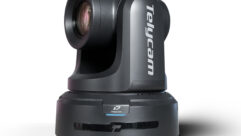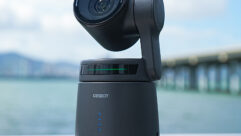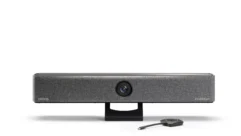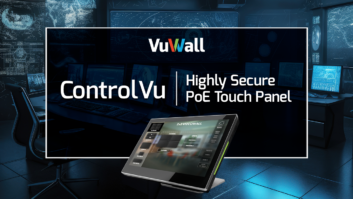
Videoconferencing Systems and Cameras
Nov 25, 2013 2:25 PM,
By Bennett Liles

AVer EVC100
It wasn’t all that long ago that a videoconference was the visual equivalent of a 1960s Transatlantic phone call. How times have changed. Special high-speed data lines and teams of technicians have morphed into a tabletop box or a wall-mounted flatpanel display with an integrated camera, taking its place among the framed photographs or paintings in the room. Data sharing, multi-preset PTZ cameras, and increasingly sophisticated echo cancellation have made communication quick and easy with only a button push or two needed to make the connection. The systems surveyed here are examples of the simplicity and affordability that have brought videoconferencing to the masses.
Aver’s answer to quick and easy videoconferencing, especially where multiple conference rooms require a larger scale deployment at low cost, is the EVC100. Comprised of the camera, codec, microphone, and IR remote, the EVC100 has VGA and HDMI outputs to support dual monitors, and with H.323 and SIP, it integrates with other videoconferencing systems. The HD fixed focus camera is a 2-megapixel, low-lux unit with 4X digital zoom and an 88-degree field of view. The codec has VGA and HDMI inputs for camera and data sharing. Calls can be made through speed dialing with hotkeys, and the system can be remotely managed, including firmware updates, on its Ethernet port with password protection. Audio inputs include the EVC microphone array and a line-in on 3.5mm mini. The sound transmission features auto gain control, noise reduction, and echo cancellation while the line outs include audio on HDMI and 3.5mm mini port. Control settings are also password protected.

Canon XU-81
As a part of the EVERCAM XU series of HD PTZ cameras from Canon, the XU-81 PTZ HD is an indoor/outdoor 1/3in. single-CMOS 1.2-megapixel camera that is used in a wide range of applications including videoconferencing systems. With its 20X HD zoom lens, it can cover a large room and provide detailed close-ups using its 128 presets. Control can be toggled between RS-232 and RS-422 while the video resolution can be switched between 1080i and 720p to fit and add to any existing videoconferencing setup. The normal mode noise rating of NC<30 will allow microphones to be installed in close proximity and its HD-SDI output enables the codec to be mounted a considerable distance from the camera when necessary. Other features include auto/manual video gain, auto/manual focus, switchable ND filter, variable shutter speed, and 12X digital zoom. The XU-81 can be mounted upright or inverted.

Cisco MX300
Cisco’s MX300 is an all-in-one videoconferencing solution consisting of a 55in. LCD display with an integrated Cisco PrecisionHD 4X zoom camera and two front-facing full-range speakers for medium-sized conference rooms with four to eight participants. Two tabletop PrecisionHD microphones complete the system, which works on a Cisco Callway Premium subscription, Cisco Unified Communications Manager (UCM), and Cisco Telepresence Video Communication Server (VCS). When using this premise-based infrastructure, an installation wizard self-configures for easy setup and expedited use. The 8in. Cisco Touch 8 interface allows simple control including one button-push calling, integration with common calendaring applications, PC content sharing, and support for H.323 and Session Initiation Protocol (SIP) with bandwidth up to 6Mbps point-to-point. The system provides video resolutions of 1080p30 and 720p60, and the monitor can be fitted with table stand, floor stand, or wall-mount options.

ClearOne Collaborate Room PHD system
The Collaborate Room PHD system from ClearOne is designed to allow participants to look their best while providing a professional, broadcast-grade videoconferencing experience. The codec has very good echo/noise cancellation, and the HDConference microphone array can be daisy-chained with up to six microphones for 360-degree sound pickup in the room. There is also recording capability on internal and external HDD for playback and archiving of important meetings. For webinars and remote training, up to 20 participants can view a session. The software-based videoconferencing solution allows flexibility, easy upgrades, future-proof scalability, and total cost of ownership along with team collaboration and HD data sharing. The system, with wireless remote control, is upgradeable to a nine-way MCU. PC files can be shared via USB during the videoconferencing session, and the system is interoperable for communication with all standard (SIP/H.323) videoconferencing devices. Video inputs are DVI and outputs are DVI and HDMI.
Videoconferencing Systems and Cameras
Nov 25, 2013 2:25 PM,
By Bennett Liles

Digital Video Enterprises Huddle Room 70
Digital Video Enterprises designed the Huddle Room 70 as a complete videoconferencing system to accommodate up to four participants at either end of the transmission or up to eight people arranged in two rows. The system allows them to appear to be in the same room by including a zero-frame 65in.-70in. HD flatscreen with HD and PC inputs as well as eye-level embedded camera(s) so that the participants can sit very close to the screen with natural eye contact. Each room comes with a boardroom-quality table custom made for each client and provides 21in. data tablets on the table for up close and easy-to-read text. There is an option for Intelligent Switched Telepresence with multiple cameras, and the Huddle Room 70 is also designed to work with any HD codec so that it can be incorporated into many existing systems as a significant upgrade.

LG V5500
Quick, easy setup and operation is the idea behind LG’s V5500 Multi Video Conference System with its intuitive interface, simple hardware, and ability to connect with a wide range of existing display devices. Dual streaming allows simultaneous on-camera communication and HD content sharing using minimum bandwidth. The GUI preset feature provides thumbnail images on the buttons so that users can easily identify the preset shot they are taking with the button push. Up to four sites can be called to participate simultaneously while the 3M CMOS camera system shows 1280x720p30 video and employs a 12X optical zoom and auto focus. The complete system consists of the conference codec, HD PTZ camera, remote control unit (RCU) with AAA battery, mic pod, and cabling. Sound system features include echo cancellation, auto noise reduction, auto gain control, and full duplex transmission.

LifeSize Room 220
The LifeSizeRoom 220 is a very compact videoconferencing solution that can be taken virtually anywhere and set up in minutes. With point-to-point throughput of 8Mbps, it has an eight-way continuous-presence multipoint bridge with transcoding and all-digital I/O. The system includes the HD PTZ LifeSize Camera 200 or the LifeSize Camera 10x, the LifeSize Phone 2nd Generation, wireless remote, and all connecting cables. All multi-party calls and data sharing are controlled on the touchscreen interface of the LifeSize phone while the video output shows a display on one or two DVI or HDMI input monitors in 1920×1080-30fps or 1280×720-60fps. System inputs include the camera, two HDMI inputs, one DVI-I connection, one component/composite, and one S-video in. There are two HD video outputs. The sound system features echo cancellation, full duplex transmission, automatic gain control, and noise reduction. The LifeSize Room 220 also enables recording and streaming of all conferences.

Panasonic KX-VC600
The KX-VC600 from Panasonic can connect up to four sites with two HDMI inputs for cameras and a VGA input for computer data sharing while showing the video output through HDMI and component connections. Its Multipoint Control Unit ensures interoperability with other videoconferencing equipment, and it is capable of using bandwidth down to 1.2Mbps for video communication. The unit has a digital audio input for use with the KX-VCA001 digital boundary microphone (up to four can be used) and an analog audio input for use with the KX-VCA002 microphone. A stereo mini input can connect a headset, and there is also an RCA line level audio input jack. The rear panel has a 9-pin RS-232 terminal for operation through a room control system in addition to the infrared remote. Audio outputs include HDMI, stereo mini for headset, and RCA for an external sound system. Panasonic has both HD fixed position and PTZ cameras available for the KX-VC600 as well as HD displays.

Polycom Group Series 700
At the top of the Group Series videoconferencing systems from Polycom is the Group Series 700 with SmartPairing technology to allow participants to use their own tablet to start and manage video calls. Delivering 1080p60 HD video, the system provides simultaneous dual-stream transmission for participants and content sharing. An optional user interface is the Polycom Touch Control, presenting a graphical user control layout on a 7in. screen. The operation is standards-based including Telepresence Interoperability Protocol (TIP) support and H.264 High Profile to connect to a variety of existing systems, and it features native interoperability with Microsoft Lync. Polycom’s interoperable Scalable Video Coding (SVC) architecture is the first to provide video calling between both existing video systems and new SVC systems. The setup includes the Polycom EagleEye III camera, codec, Polycom RealPresence Group Microphone Array, cables, and remote control. Two cameras can be used, and there are three HDMI inputs, component, and VGA.
Videoconferencing Systems and Cameras
Nov 25, 2013 2:25 PM,
By Bennett Liles

Radvision Scopia XT5000
Radvision designed the Scopia XT5000 to incorporate dual 1080p/60fps live video and content, HD audio, H.264 High Profile, Scalable Video Coding Technology (SVC), and multi-party calling. Features include an embedded nine-way multiparty MCU and iPad multi-touch control. Its two simultaneous 1080p video channels can carry two camera signals or camera and HD content sharing. The camera, with its 10X optical and 4X digital zoom, can pan 100 degrees and tilt ±25 degrees while the sound system provides acoustic echo cancellation, automatic gain control, adaptive post filtering, and automatic noise suppression. The Scopia XT5000 provides HDMI and DVI-I video inputs, two HDMI outputs for dual display, audio inputs including HDMI, mic array pod, and mini analog/digital with a mini Toslink adapter. Its networking capability includes full duplex transmission, IP adaptive packet management, IPv4 and IPv6 simultaneous support, along with embedded encryption. An additional Digital Microphone Array Pod is available as an option.

Smart Technologies SMART Room System for Microsoft Lync
Smart Technologies has the Smart Room System for Microsoft Lync that can be matched in size to any specific need from one 70in. display or an 84in. screen up to two 70in. monitors with an integrated camera that automatically adjusts to the room lighting level and shows a 98-degree horizontal field of view. Equipped with digital pan, tilt, and zoom (DPTZ), the camera also features automatic white balance and automatic exposure control. The whole system turns on when participants enter the room and the conference can be started with one button push. The central tabletop component is the small administrative console with a 1366×768 screen on which all functions are activated and transmission can be switched between camera and whiteboard content. Up to four tabletop microphones with mute button and indicator can be connected for better sound pickup.

Sony PCS-XG80 Visual Communication System
User friendliness is built into the PCS-XG80 Visual Communication System from Sony with its intuitive graphical user interface that employs a simple layer structure and translucent cascading menus. It also features one-touch dialing, an embedded MCU for multiple connections, and a new RF Remote Commander that eliminates the need for line-of-sight contact with the main unit. Backward compatible with SD systems and TU-T H.239 compliant, it allows simultaneous on-camera communication and data sharing from a PC. A third-party pen tablet can be used for annotations over specific parts of an image. The H.264 video codec provides natural HD images at a resolution of 1920×1080 while the sound system uses the MPEG-4 AAC compression format. Up to five remote sites can be connected using the optional MCU software. In four-screen and six-screen 720p continuous presence modes, while using voice-activated switching, the remote site where participants are currently talking will be displayed in the largest sub-screen. For secure conferencing, the PCS-XG80 supports 128-bit AES encryption.

Vaddio GroupStation
The GroupStation from Vaddio is designed for mid- to large-sized videoconference venues, and it can connect for HD collaboration using Skype, Microsoft Lync, WebEx and other applications as well as SIP-based Voice over IP for audio conferences. Internet video streaming and data from local sources such as PCs and tablets can also be used. The system consists of a control dock with 4-AEC mics, controller, and dialer as well as a wall unit with amps, speakers, and camera. The camera has a 19X optical zoom with a maximum field of view greater than 58 degrees, and it can make color images down to a light level of 0.7 lux. Along with all other GroupStation functions, the auto-focus camera pan and tilt are controlled from capacitive touch buttons on the dock. The dock also has connections for a PC, laptop or tablet, or HDMI or VGA inputs to locally extend the PC to the room monitor and a USB 2.0 UVC and UAC-compliant connection. The wall unit is placed directly above a flatscreen display and contains speakers and the camera. The dock and the wall unit are connected by a 25ft. length of Cat-6e shielded cable.










